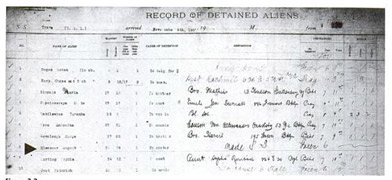 |
||
| HOME INTERVIEWS WHAT DO WE LOOK FOR? OUR BRIAND FAMILY CONTACT | ||
|
STOWAWAYS |
 |
A GENEALOGICAL MYTH |
 |
||
| HOME INTERVIEWS WHAT DO WE LOOK FOR? OUR BRIAND FAMILY CONTACT | ||
|
STOWAWAYS |
 |
A GENEALOGICAL MYTH |
 |
Vasco Núñez de Balboa, -who was a famous Spanish conqueror for being the first one who arrived to the Pacific Ocean, which he called "South Sea", crossing the Isthmus of Panama-, came to America in 1501, when he was 26 years old. He passed through Panama and the Caribbean Coasts until reaching Cabo de la Vela, actually Columbia. With the incomes of this successful campaign, he settled ground in La Hispaniola, (currently Haiti), where he was working as a planter and pig farmer. After 10 years of labor, his business started to decline, and he borrowed huge amounts of money. Not being able to pay them back, chased by his creditors, he set sail on a ship, hidden inside a barrel with his little dog Leoncico, in an expedition commanded by the Mayor of Nueva Andalucía, Martin Fernandez de Enciso. He was encountered during the maritime travel, and the Captain Fernandez de Enciso tried to get him ashore in the first desert island he saw at the horizon. But later, persuaded about the importance and the knowledge of the explorer, he forgave him, traveling together until the end of the expedition. In this way, Núñez de Balboa becomes the first stowaway of whom we have notices in our American history. |
|
There's a genealogy myth, or a legend, about those grandfathers, or great-grandfathers who arrived to America as stowaways in a ship. When references about the first arrival of an ancestor are not found, families use to transform this fact in "stowaway arrived in a ship". However, on the contrary of what is generally assumed, stowaways have been always documented in all the records and passengers lists. More of the 90% of stowaways have been always detected, identified and recorded either in high seas or arriving to the ports. For a better understanding, we can see how was ruled in the past and which is the current legislation about stowaways. Stowaways existed since the navigation exists, and always have had some rules established by the practice and the custom about them. When they are found in high seas, the maritime expression is "frustrated stowaway". If they are found into territorial waters, they could be delivered in a boat toward the coast. Out of territorial waters, it starts to be a navigation's company liability , which must assume all the expenses of transportation, disembark and medical attention, whenever it is necessary. During the travel it's completely forbidden to a ship to deviate its route with the intention of get ashore stowaways. What was always done at the discovering of a stowaway, was to put him to work to compensate the costs of having him on board. After being identified, the documents are verified. If documentation is in rule, they are registered in the passenger's list at the bottom line, specifying their condition on board. Another option is to keep them working in the ship, up to the arrival to the next port, being in this case recorded as a steam crew member. Here we have, then, two ways in which stowaways are registered in ships' lists. The expenditures caused by stowaways, since the foundation of the first maritime insurance company, the Lloyd of London, in 1688, never were covered by maritime insurances. It was a way to enforce the navigators to keep all the right procedures about this situation, like inspections of ships and ports, good illumination in dark areas, and checking all the possible hiding places. However, the Clubs -maritime mutual companies which always have covered what is not covered by insurances- used to take care of those expenses. How a stowaway aboard a ship? There's two traditional ways: somehow hidden in a dark place, or with a visitor pass before the steamship leaves the port. After that is, probably, hidden in a closet, or protected by the same passengers. They use to provide the stowaway with food and clothing. In the case the stowaway doesn't know anybody in the ship, must be permanently hidden, passing a lot of days without food, and it's probable that at the arrive to the destination would be sick, with fever or infections. In that case, before to proceed with the legal situation, the authorities must send him to get medical assistance, with all the expenses covered by the navigation company. It's pretty difficult that a stowaway could reach a destination and to run away from the ship without being noticed by anybody. Usually ports are very well watched and the disembarks very well controlled. If captains could let them go without being observed by anybody, no doubt they would do it, just to avoid future expenses. But the authorities at the ports use to control very well those situations, and it's very improbable, if not impossible, to foul them around. Once in firm land, stowaways can ask for refuge or asylum, by reasons of wars, politic persecution, or extreme necessity, being frequently in those cases accepted by almost all the countries, provided that their documents are in rule. If they wouldn't have identification documents, they will be likely repatriated in the next ship of the same company which brought them to the port. Also they could be sent back if the motivation they mention for their illegal action is not enough satisfactory, such like they stowaway for adventure, with the intention of knowing a little of the world, or similar reasons. Almost all the stowaways have always been men. Very few women were found hidden in a ship. During the 19th century and at the beginning of the 20th century, they were put in custody of a man, either being a relative or a family friend, at the port of destination. Women never were left alone. When they are pregnant, deportation must not be executed in any way. |
 |
It was a famous case, in 1928, when Rose Host got aboard the Manchuria, in New York, with a visitor pass, and she remained on the steamship when it set sail from the port. Few hours later she presented herself to the captain, saying that she didn't have a single cent to afford the ticket for the travel. As putting her ashore in the first port, La Havana, could have cost money to the company, they set her to work as a clerk in the purser's office. In that way she paid for her travel to the Panama Pacific Co., which since that day was extremely careful about women visiting passengers in their ships. |
|
Actually stowaways are ruled by the Convention on Facilitation of International Maritime Traffic (FAL 65) which entered in force in May 2003. Formerly was organized the Convention of Brussels of 1957, but it never was approved because it suggested that the countries of destination must afford the expenses due to stowaways. Indubitably some of our ancestors (not as much as it's generally thought) arrived to American ports as stowaways. On the Ellis Island databases many of them are recorded on lists like this one: |
 |
|
Usually, when passengers lists are available, in all the countries and in all the ports, stowaways are registered on them. The main genealogical websites have stowaway records on line. Nevertheless, the "myth of the stowaway" is one of the most common myths in family stories. As common as the myth of the noble ancestors or the myth of being related with some famous character in the History carrying the same last name. The best goal to brake with all this fantasies is to make a good research. It's more romantic, more "picturesque", to have an ancestor who came to America starving in a ship and years later became the landlord of a lot of acres. But, as all the myths and family legends, many times is not true. And if it's true, the information is available, anyway.
Pablo Briand, July 25 2009 |